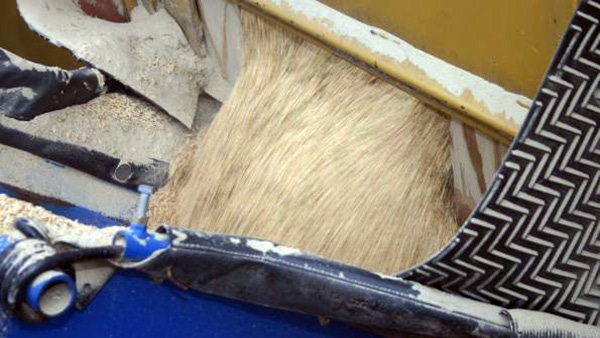
How bad is California’s four-year drought? A report from NASA says the state needs 11 trillion gallons of water in order to pull out of its dry tailspin.
That’s why farmers are being offered – and seriously considering – selling their water to municipalities and sitting out the growing season. If those sales are made, might that mean medium-grain rice production would shift to the Mid-South?
Medium-grain rice may tempt Mid-South producers
On March 19, Delta Farm Press spoke with Dwight Roberts, president of the U.S. Rice Producers Association, about the possibilities and how things stand going into a new cropping season. Roberts, based in Houston, Texas, says farmers in his area are itching to get into the field. Among his comments:
On planting progress along the Gulf Coast…
“The farmers around here are wishing the sun would come out and dry up the fields. They’re tired of waiting to plant, they’re antsy. The equipment is prepped and fueled and clean. There’s only so much you can do at the shop.

More on Mid-South rice
“There’s been hardly any rice planted along the Gulf Coast. I know of no one in Texas that’s been able to get in the field. I’m told south Louisiana has planted only about 1,000 acres. Here it is the third week of March and normally 10 percent, or better, is planted by now.
“I called one of largest rice farmers – over 4,000 acres – east of Houston. He hasn’t planted a single seed and there’s rain in the forecast. I asked him if the sun came out today and there was no more rain how long it would take to dry down. He said it would be another two weeks. Get very far into April and that eliminates the possibility of a ratoon crop.”
More medium-grain?
On the possibility of moving some medium-grain acreage to the Mid-South…
“There are a number of factors playing into the U.S. rice situation. The overall appearance of the long-grain rice market isn’t too friendly. But on the medium-grain side it’s more positive.
“It all starts with water, of course, and that’s especially true in California. They just don’t have the water levels. The mountain ranges that feed into the rivers don’t have the snow melt and rains haven’t come. The residents out there are years into a major drought now. (See California farmers already under drought emergency)
“On April Fool’s Day, I’m told state officials will read the water levels again and additional decisions on water use will be made. I’m told they aren’t expecting any break in the drought, though. Before that April 1 announcement, though, municipalities are offering California farmers quite a premium for their water -- along the lines of $700 per acre foot.
‘One acre of rice requires about three acre feet of water. An acre foot is about 325,000 gallons. So, if you idle an acre of rice that would mean the farmer could get about $2,100 for his water. Compare that to growing a rice crop and coming away with $1,000 to $1,500 per acre depending on the price and yields and inputs.
“Personally, it wouldn’t take me long to sell my water to Hollywood and relax for the season. If Brad Pitt and the Kardashians want to pay that much, have at it.
“Now, that doesn’t mean rice won’t be grown in California. I’m sure there are farmers that aren’t leaping at the chance to sell their water. Rice is a vice, truly. Some farmers I know are taken up with the crop. They just have to grow it.
“I’ve heard numbers everywhere from 350,000 to 420,000 rice acres in California this year. Producers were growing over 500,000 acres not that long ago. Last year, they idled about 140,000 acres of rice. So, it’ll be interesting to watch what happens. The rice acres could be far lower than the acreage estimates.”
What might that do to the medium-grain price?
“I’ve come to learn that just because the supply dips doesn’t mean that the price will jump extremely high. The price will get a bump but if it goes too high, you’ll price yourself out of the market. Southern producers need to remember that before going big into medium-grain production.
“Calrose is the medium-grain rice that’s held sacred in California. Calrose, paddy rice, is around $530 per ton. On a milled basis, it’s around $850 to $870. Meanwhile, the Southern medium grain, Jupiter, is around $375 for paddy rice and $625 milled.
“The medium-grain market is special and rather limited. There is domestic use from cereal companies and the like. On the international scene, the supply side is driven largely by what goes on in Australia, Egypt and a few other countries. (See World rice markets - good, bad and frustrating)
“On the buying side, Turkey is famous for purchasing large amounts of Calrose. When the price gets too high, they turn to Jupiter (a medium-grain grown in the Mid-South). And congratulations to the team that developed Jupiter, which replaced Bengal. They did a great job and Jupiter is good quality.”
Opportunity
On rice in the South…
“I think everyone understands that the demise of an aspect of an industry is an opportunity for another aspect. Right now, the Southern rice planting outlook is literally stuck in the mud. But I can’t see that the current situation won’t do anything but help encourage more medium-grain rice to be planted in the region. It would certainly help farmers facing long-grain price that are the lowest in over 10 years.
“Of course, that would mean having a separate set-up to manage the medium-grain rice. You have to keep it separated from long-grain. The thing is if there is indeed a shift to medium-grain in the South, it would probably stick around until the drought ends out West.”
About the Author(s)
You May Also Like




